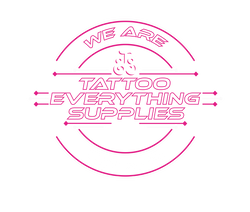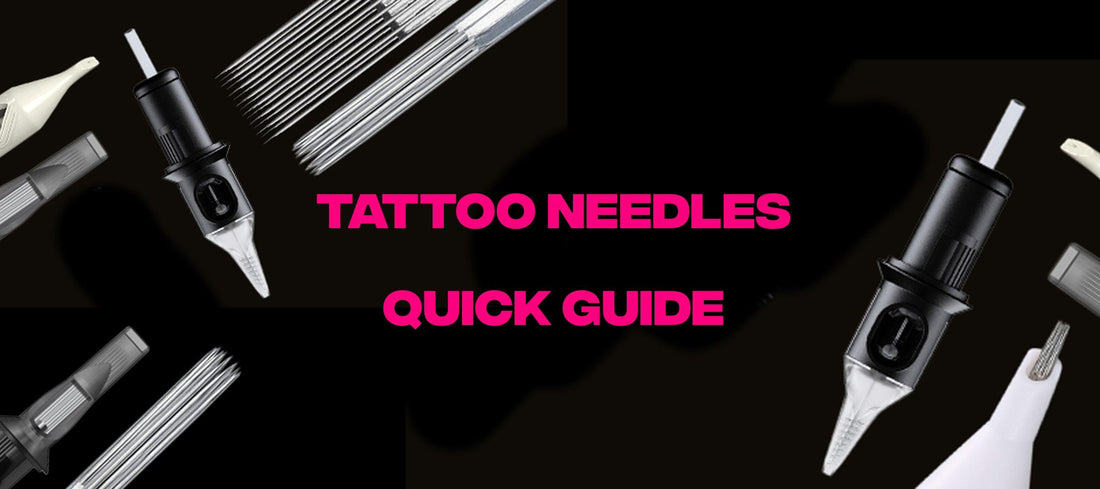Whether you are new to tattooing or a professional tattoo artist, the large selection of different tattoo needle sets, diameters, tapers and needle counts can be overwhelming.
This guide will help you understand the meaning and use of all sizes of tattoo needles and in turn help you make the most informed decision when buying a tattoo needles.

The diameter, or gauge of the tattoo needle is the the thickness of each individual needle at its widest point. The gauge of a needle is linked to ink flow; the larger the gauge, the more ink it holds and deposits into skin. A tattoo with a smaller gauge needle will hold and deposit less ink.
Though there are many gauges (with some Magnum Shaders going up to 25), there are three sizes that are most popular in tattooing.
#8 GAUGE (0.25MM)
This is a small needle, and are often called Bugpins, the ink flows a bit slower so it is good for intricate detailing.
#10 GAUGE (0.30MM)
This is very popular among tattoo artists, it tends to be the middle ground. It gives a steady flow but doesn’t restrict and slow it down as much as the #8 gauge. 10s are often referred to as 'double zeros'' in the tattoo industry.
#12 GAUGE (0.35MM)
A 12 gauge might be referred to as standards, but they have a faster flow of ink which means they are good for shading and colouring large areas.
The needle count is determined by how many individual sharps make up the whole needle. The more sharps included, the bigger the tattoo needle will be.
Configuration
A needle’s configuration describes how the individual needles (sharps) are set up on the needle bar. For example, Round Liner, Magnum, Curved Magnum
Taper
This is how much the needles taper toward the end. A standard taper for a tattoo needle is 1.5mm. A taper can go all the way to 8mm. The longer the taper, the more likely it is to be used to lots of shading because it causes less trauma to the skin. Occasionally, the taper will not be listed, and there will only be three numbers.
Needle Configurations

Round Liner or ( RL )
The sharps on round liner needles are soldered in a round pattern to produce crisp, clean lining tattoo work. The thickness of the line will depend on the number round liner you choose (e.g. 01 very fine, 14 very thick)
Hollow Liner
Hollow Liners are similar in design to Round Liner tattoo needles. But they’re referred to as “hollow” because the center is completely open without a needle in the center of the circular grouping as you would see in a round liner, allowing for better and longer ink flow especially for bold linework using larger groupings. Many traditional and new school artists count on hollow liners for producing crisp, clean linework.
Round Shader or ( RS )
Similar to round liners, round shaders are a circular cluster of needles. The main difference between liner and shader needles is there's more space between each pin for increased ink flow. Shaders can be used for small area filling in of colour, blending and shading a tattoo.
Flat Needles
Flat shader needles are pins that are soldered in a straight line on the needle bar. These needles are used for lining because their shape lets them deliver more ink to the skin. This means clearer, darker lines with just one stroke. Larger flat needles can be used for color fills and shading as they deliver more ink quickly with just one pass.
Magnum Needles
Magnum needles deliver a lot of ink and make them the ideal needle for almost all shading work. They let out a lot of ink at once, instead of round liners that just deliver a small amount at once. Due to the fact that they let so much ink out, you have to pass over an area fewer times, making these needles great for shading in large areas.
Magnum needles are stacked in a row of two, one on top of the other. This can range from 7 pins stacked with three on top of four, to 27 pins stacked with 13 pins on top and 14 on the bottom.
Curved Magnum (Soft)
Curved Magnum shader needle are quite the same as normal magnum needles, except that the arrangement of the needles forms a central arch. As a result, the ink will disperse better, the line is more uniform, good for soft shading, and the skin has less trauma.

